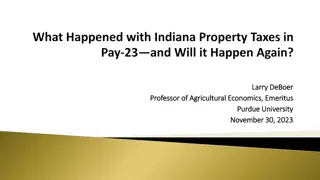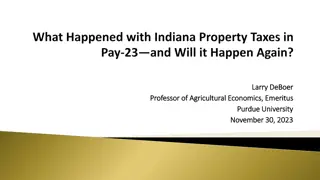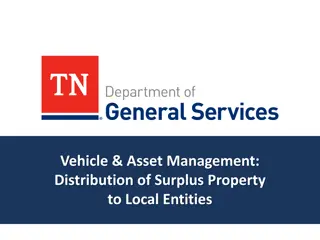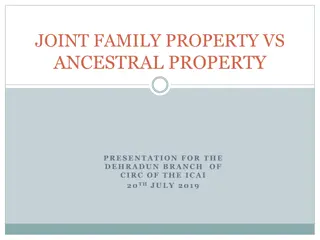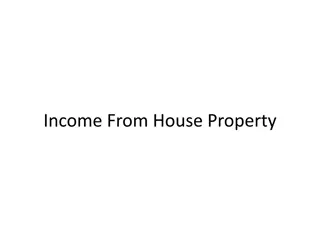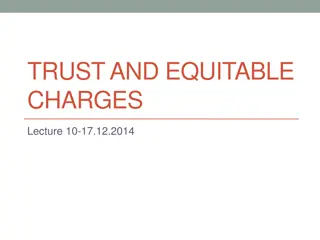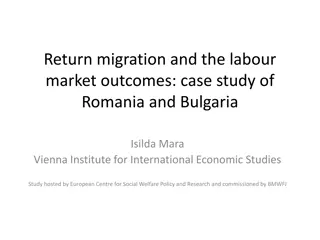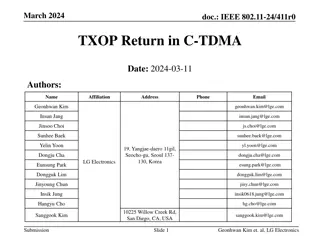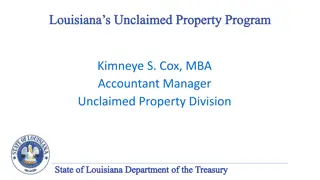
Property Performance and Market Trends for Financial Analysis
Delve into the intricacies of property performance and market trends with a focus on historical rates of return, covariance, and correlation coefficients. Discover how fluctuations over time impact investment decisions in the financial realm.
Download Presentation

Please find below an Image/Link to download the presentation.
The content on the website is provided AS IS for your information and personal use only. It may not be sold, licensed, or shared on other websites without obtaining consent from the author. If you encounter any issues during the download, it is possible that the publisher has removed the file from their server.
You are allowed to download the files provided on this website for personal or commercial use, subject to the condition that they are used lawfully. All files are the property of their respective owners.
The content on the website is provided AS IS for your information and personal use only. It may not be sold, licensed, or shared on other websites without obtaining consent from the author.
E N D
Presentation Transcript
Lecture 6 Property performance and Market trend Dr. Liming Yao l.yao@shu.ac.uk
Recap: Geometric Return and Average Returns (geo-return:1.9492%) vs (average return:2.584%) Geometric return is lower/higher than average return (and will always be). In financial analysis, don t use average return/geometric return approach (as it gives your biased results). Average return/Geometric return gives more accurate returns.
This session Evaluate property return and market trend
Evaluate Property Performance Historical rates of return- these are the returns of an individual investment over time Evaluate property average return geometric return Observe property fluctuations over time line chart Compare with market returns covariance correlation coefficient
Line Chart Observe fluctuations and relationships over time tend to move in the same direction tend to move in the opposite direction Property returns against MSCI UK All Property annual returns 40.0 30.0 Return (%) 20.0 10.0 0.0 Jan 1981 Jan 1982 Jan 1983 Jan 1984 Jan 1986 Jan 1987 Jan 1988 Jan 1989 Jan 1991 Jan 1992 Jan 1993 Jan 1994 Year Jan 1996 Jan 1997 Jan 1998 Jan 1999 Jan 2001 Jan 2002 Jan 2003 Jan 2004 Jan 2005 Jan 2006 Jan 2007 Jan 1985 Jan 1990 Jan 1995 Jan 2000 (10.0) (20.0) MSCI IPD data Property returns
Line Chart Analysis of fluctuations of returns: refer to specific time period or specific occasions, e.g. GFC, Brexit, Covid, etc
Covariance In Statistics: Is an absolute measure of the extent to which two sets of numbers move together over time. In Finance: Is a measure of the joint variability of two datasets. Is a measure of the relationship between two variables. In your dataset: Is a measure of the joint variability of your property and the market
Statistics-Covariance Property and Market tend to move in a same direction They have positive relationship They have a positive covariance Property and Market tend to move in a different direction They have negative relationship They have a negative covariance
Investment suggestions Positive covariance between property and market property tends to follow the market trend when market booms, property return sees an increase (highly likely to gain); when market drops, property return will see a decrease (highly likely to lose) Negative covariance between property and market property tends to have a different trend relative to the market when market booms, property return sees a decrease (highly likely to lose); when market drops, property return will see an increase (highly likely to gain)
Positive Covariance From the chart: property A and market moves in the same trend over time: Covariance cov=30.9446 They increase or decrease over the same time period. If you invest in property A, describe your investment performance from 2011 onward? To gain or to lose? Why?
Property return over 2008-2016 Negative Covariance 30.00 25.00 20.00 15.00 10.00 5.00 0.00 2008 2009 2010 2011 2012 2013 2014 2015 2016 Property B Market calculation : covariance between property B and market cov=-31.9879 Their relationship? If you hold investment B, describe your investment return from 2013 and onward?
Example Mr.Smith is a risk-hiking investor, has a choice of two portfolios. The following table shows the relationship between each property and the market (measured by covariance). Try to interpret the covariance, and make an investment decision for Mr. A: Portfolio A Portfolio B Office A (cov=39.6) Warehouse A (cov=103.89) Property X (cov=-79.3) Student accommodation B (cov=110.3) Office C (cov=70.12) Out of Town office C (cov=68.2)
Correlation Correlation is used to measure the direction of a relationship between two random variables. returns tend to move in a same direction: positive correlation returns tend to move in an opposite direction: negative correlation Property return over 2008-2016 30.00 25.00 20.00 15.00 10.00 5.00 0.00 200820092010201120122013201420152016 Property B Market
Correlation Coefficient In addition to evaluate the direction of the relationship, correlation is used to measure the strength of a relationship between two variables strong correlation weak correlation no correlation Using ?to stand for the correlation coefficient (r) ranges between (-1, 1) can be 0 if there is no relationship
Direction of ? The sign (+/-) of the correlation coefficient (?) tells us the direction of the relationship: -negative sign, there is a negative relationship between two variables -positive sign, there is a positive relationship between two variables
Evaluate the correlation coefficient ? Correlation Coefficient Interpretation Value Very strong positive relationship 0.8 to 1.0 Strong positive relationship 0.6 to 0.8 Moderate positive relationship 0.4 to 0.6 Weak positive relationship 0.2 to 0.4 No relationship or very weak positive relationship 0.0 to 0.2 Very strong negative relationship -0.8 to -1.0 Strong negative relationship -0.6 to -0.8 Moderate negative relationship -0.4 to -0.6 Weak negative relationship -0.2 to -0.4 No relationship or very weak negative relationship 0.0 to -0.2
Example Using the table in previous page, evaluating the following correlation: correlation coefficient between Market and Office A=0.98 Very strong positive relationship correlation coefficient between Market and Retail=0.35 Weak positive relationship correlation coefficient between Market and Distribution Warehouse=-0.75 Strong negative relationship
Investment suggestions Positive correlation coefficient between property and market property tends to follow the market trend when market booms, property return sees an increase; when market drops, property return will see a decrease In a portfolio, try to diversify your properties: include some property with negative correlation with the market or at least include property with less strong positive correlation with the market.
Example Mr.Smith is a risk-averse investor, has a choice of two portfolios. The following table shows the correlation coefficient between each property and the market. Try to interpret the correlation coefficient, and make an investment decision for Mr. B: Portfolio A Portfolio B Office A (r=0.86) Distribution Warehouse A (r=0.93) Distribution Warehouse B (r=0.59) Student accommodation (r=0.91) Retail Park C (r=0.32) Retail (High street) (r=0.63)
Covariance vs Correlation Covariance Correlation Is a measure of the joint variability of two variables. Can be a positive or negative value. Only tells the direction of the co-movement of two variables. It can be any values (apart from 0) Measures the degree of the relationship between two variables. Can be a positive or negative value. It tells the degree and direction the relationship. Ranges between [-1, 1] -1 ? 1
Q: How can you start to analyse your data and decide which portfolio to choose for your assignment?
NEXT WEEK Evaluate property risk Diversification
Reading Brown, Keith C. & Reilly, Frank K. (2009) Analysis of investments and management of portfolios . 9th ed., International student ed. Mason, Ohio?: South-Western Cengage Learning. Chapters 1, 3, and 7.


